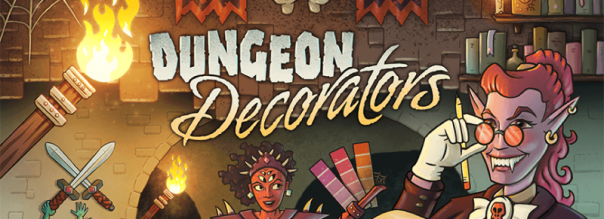Interior Design for Ghouls
What’s a dungeon without a rack of swords? The odd pile of bones? A tasteful corridor-obstructing sheet of cobwebs? In Jeff LaFlam’s Dungeon Decorators, probably not very many points. Depending on which scoring card you’ve drawn, that is.
There’s a good chance its title has already filled you in on the basic idea behind Dungeon Decorators, provided you aren’t making assumptions about the marketability of games about the, uh, other type of dungeon. The previous evil overlord has shuffled off this mortal coil — yeah, R.I.P. — so your skills as a licensed decorator of dank corridors are suddenly in demand as would-be replacements begin looking to build their own lair. And your Dad always bellyached that an undergrad in interior design was “too soft.”
What does dungeon decorating entail? For the most part, wringing your hands over the right tiles appearing from one of the game’s two bags. This is a drafting game, built around a system that will be familiar to anybody who’s played Kingdomino. Tiles appear from a bag and are ordered according to their increasing numerical value. Then everybody chooses a tile, with your selection not only offering layouts, decorations, and bonuses, but also determining your draft order on the next turn.
Both the drafting and the construction are easy enough to figure out, although there are a few particularities you’d do well to master. My personal highlight is the graphic design of the tiles themselves. Because every tile is two-sided, with hallways and chambers on one side and decorations and bonuses on the other, it’s easy to imagine how cantankerous this process could have been, with everyone repeatedly flipping the tiles in order to get some sense for what they’re drafting. Instead, the “decoration” side of the tile provides all the information necessary to make a decision. The placement of a tile’s decorations reveals where the reverse side’s hallways are located, as well as whether there’s a bonus star or any special carpeting. In such a visual medium, there’s a lot to be said for a game offering both options and clarity, and Dungeon Decorators succeeds at both.
The construction is similarly breezy. Either you’re arranging hallways or placing decorations in the gaps. There isn’t too much to this process, although planning ahead can pay big in the long run. In many cases, you’ll have access to a tile with decorations on multiple sides, so it behooves you to create opportunities for a single tile to add its ornaments to multiple chambers or hallways. In modern fashion, points are awarded for nearly everything: special stars, the color of the carpet, which color you have the most carpet of, and, most importantly, whether you can meet the demands of three types of scoring cards.
Unfortunately, it’s these scoring cards that begin to show the thinness of this dungeon’s mortar.
In the game’s first half, every tile counts. This is thanks to the way cards are scored, awarding points for either particular arrangements or sets of decorations. You might, for example, hope to create an “indoor swimming bog,” consisting of a green tile next to a yellow tile, or adorn a hallway with both a desk and a hidden switch. Very well — time to draft the most appropriate offerings.
As the game progresses, however, it becomes apparent that points might be more easily won. Say, by filling your sprawling single hallway with as many decorations as possible, then always drawing from the deck of decoration goals in an attempt to get scoring cards that you’ve pretty much already achieved. Of course, you won’t always draw a card whose conditions you’ve already met — although I’ve seen that happen a fair number of times. Rather, it’s easy to find yourself in a situation where even the smallest of modifications, such as rotating a tile or the addition of one or two extra chambers, will pay out a heap of points for very little effort.
In other words, the game’s final half tends to feel like it’s more about drawing as many cards as possible rather than working to fulfill the objectives already in your hand. The dungeon itself becomes secondary, even perfunctory. Dead, unpopulated corridors with things stashed against the walls. This emptiness becomes pronounced even within a single play. Where are the minions? The traps? The adventurers, hunting for the glittering prizes you’ve squirreled away? One enormous hallway with a few chambers sprouting from it hardly makes a compelling space.
Perhaps I’ve been spoiled by bolder attempts. It’s never entirely fair to wish for the game we didn’t get, and Dungeon Decorators manages to provide a pleasant enough time for very little overhead. Still, it’s hard to want to return to its whistling corridors when other titles also feature the creation of organic spaces while also filling them with life and purpose. Despite the tried-and-tested drafting, the ease of construction, the gratification of raking in victory points, the conclusion tended to come as a relief, not a climax. This dungeon is more of a floor plan than an evil lair.
(If what I’m doing at Space-Biff! is valuable to you in some way, please consider dropping by my Patreon campaign or Ko-fi.)
A complimentary copy was provided.
Posted on October 14, 2021, in Board Game and tagged Board Games, Dungeon Decorators, SlugFest Games, The Fruits of Kickstarter. Bookmark the permalink. 1 Comment.




Thanks for sharing these dungeon decorators.
https://closingcurtain.ae/